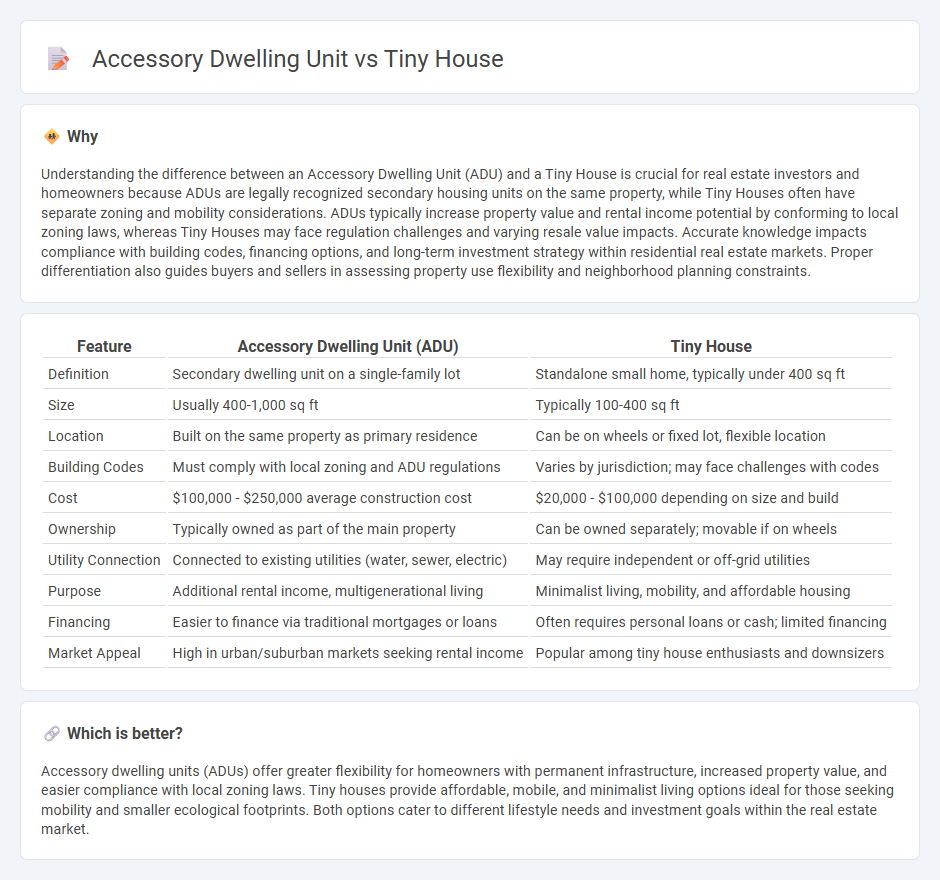
Accessory dwelling units (ADUs) are secondary housing units located on the same lot as a primary residence, offering flexible living space without the need for new land development. Tiny houses, typically under 400 square feet, emphasize minimalist living with self-contained features and can be mobile or fixed structures. Explore the distinctions and benefits of each to determine the best fit for your real estate needs.
Why it is important
Understanding the difference between an Accessory Dwelling Unit (ADU) and a Tiny House is crucial for real estate investors and homeowners because ADUs are legally recognized secondary housing units on the same property, while Tiny Houses often have separate zoning and mobility considerations. ADUs typically increase property value and rental income potential by conforming to local zoning laws, whereas Tiny Houses may face regulation challenges and varying resale value impacts. Accurate knowledge impacts compliance with building codes, financing options, and long-term investment strategy within residential real estate markets. Proper differentiation also guides buyers and sellers in assessing property use flexibility and neighborhood planning constraints.
Comparison Table
| Feature | Accessory Dwelling Unit (ADU) | Tiny House |
|---|---|---|
| Definition | Secondary dwelling unit on a single-family lot | Standalone small home, typically under 400 sq ft |
| Size | Usually 400-1,000 sq ft | Typically 100-400 sq ft |
| Location | Built on the same property as primary residence | Can be on wheels or fixed lot, flexible location |
| Building Codes | Must comply with local zoning and ADU regulations | Varies by jurisdiction; may face challenges with codes |
| Cost | $100,000 - $250,000 average construction cost | $20,000 - $100,000 depending on size and build |
| Ownership | Typically owned as part of the main property | Can be owned separately; movable if on wheels |
| Utility Connection | Connected to existing utilities (water, sewer, electric) | May require independent or off-grid utilities |
| Purpose | Additional rental income, multigenerational living | Minimalist living, mobility, and affordable housing |
| Financing | Easier to finance via traditional mortgages or loans | Often requires personal loans or cash; limited financing |
| Market Appeal | High in urban/suburban markets seeking rental income | Popular among tiny house enthusiasts and downsizers |
Which is better?
Accessory dwelling units (ADUs) offer greater flexibility for homeowners with permanent infrastructure, increased property value, and easier compliance with local zoning laws. Tiny houses provide affordable, mobile, and minimalist living options ideal for those seeking mobility and smaller ecological footprints. Both options cater to different lifestyle needs and investment goals within the real estate market.
Connection
Accessory dwelling units (ADUs) and tiny houses both serve as compact, efficient housing solutions that maximize residential property use and increase housing affordability. ADUs are secondary living spaces built on the same lot as a primary residence, while tiny houses are standalone small homes often designed for minimal environmental impact and flexible living. Both address housing shortages by offering scalable, cost-effective alternatives to traditional homes, appealing to homeowners and urban planners focused on sustainable development.
Key Terms
Zoning Regulations
Zoning regulations for tiny houses often categorize them as recreational vehicles or temporary dwellings, limiting their placement and long-term habitation, whereas accessory dwelling units (ADUs) are typically recognized as permanent residential structures with established guidelines for setbacks, size, and utility connections. Many municipalities have specific zoning codes encouraging ADUs to increase housing density and affordability, which can make ADU permits easier to obtain compared to tiny houses. Explore local zoning laws further to determine which option best fits your property and living goals.
Primary Residence
Primary residences in tiny houses offer compact, efficient living spaces typically under 400 square feet, designed for full-time occupancy with a focus on minimalism and mobility. Accessory dwelling units (ADUs) serve as secondary housing on the same property as a primary residence, often providing additional living space while maintaining legal residence status at the main home. Explore detailed comparisons on zoning laws, design flexibility, and livability to determine the best fit for your primary residence needs.
Permitting
Permitting for tiny houses and accessory dwelling units (ADUs) varies significantly depending on local zoning laws and building codes, with ADUs often benefiting from more established regulatory frameworks. Tiny houses on wheels usually face stricter restrictions due to their mobile nature, while stationary ADUs must comply with specific size, utility, and safety standards mandated by municipalities. Explore detailed permitting requirements and zoning considerations to determine the best fit for your housing project.
Source and External Links
Tiny-house movement - Wikipedia - The tiny house movement is an architectural and social trend advocating for smaller, simplified living spaces, often defined as under 400-600 square feet, offering lower costs and eco-friendly options but also facing legal, zoning, and storage challenges.
Unique One-Level Tiny Home Tour for Easy Living - YouTube - This video showcases a thoughtfully designed one-level tiny home that feels spacious, bright, and connected to the outdoors, challenging the misconception that tiny living means sacrificing comfort or storage.
Modern-Minimalist Two-Trailer Tiny Home | A Genius DIY ... - YouTube - A DIY enthusiast's modern, minimalist tiny home built on two trailers highlights innovative storage solutions and a social, open layout that maximizes functionality and style in a compact footprint.
 dowidth.com
dowidth.com